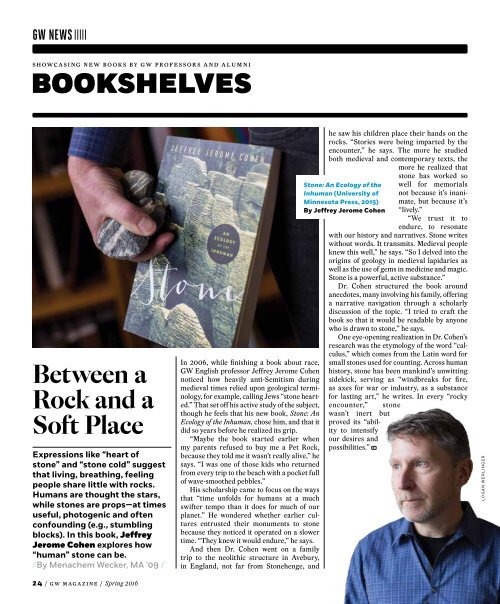Create successful ePaper yourself
Turn your PDF publications into a flip-book with our unique Google optimized e-Paper software.
GW NEWS<br />
showcasing new books by gw professors and alumni<br />
BOOKSHELVES<br />
Between a<br />
Rock and a<br />
Soft Place<br />
Expressions like “heart of<br />
s<strong>to</strong>ne” and “s<strong>to</strong>ne cold” suggest<br />
that living, breathing, feeling<br />
people share little with rocks.<br />
Humans are thought the stars,<br />
while s<strong>to</strong>nes are props—at times<br />
useful, pho<strong>to</strong>genic and often<br />
confounding (e.g., stumbling<br />
blocks). <strong>In</strong> this book, Jeffrey<br />
Jerome Cohen explores how<br />
“human” s<strong>to</strong>ne can be.<br />
/By Menachem Wecker, MA ’09 /<br />
<strong>In</strong> 2006, while finishing a book about race,<br />
GW English professor Jeffrey Jerome Cohen<br />
noticed how heavily anti-Semitism during<br />
medieval times relied upon geological terminology,<br />
for example, calling Jews “s<strong>to</strong>ne hearted.”<br />
That set off his active study of the subject,<br />
though he feels that his new book, S<strong>to</strong>ne: An<br />
Ecology of the <strong>In</strong>human, chose him, and that it<br />
did so years before he realized its grip.<br />
“Maybe the book started earlier when<br />
my parents refused <strong>to</strong> buy me a Pet Rock,<br />
because they <strong>to</strong>ld me it wasn’t really alive,” he<br />
says. “I was one of those kids who returned<br />
from every trip <strong>to</strong> the beach with a pocket full<br />
of wave-smoothed pebbles.”<br />
His scholarship came <strong>to</strong> focus on the ways<br />
that “time unfolds for humans at a much<br />
swifter tempo than it does for much of our<br />
planet.” He wondered whether earlier cultures<br />
entrusted their monuments <strong>to</strong> s<strong>to</strong>ne<br />
because they noticed it operated on a slower<br />
time. “They knew it would endure,” he says.<br />
And then Dr. Cohen went on a family<br />
trip <strong>to</strong> the neolithic structure in Avebury,<br />
in England, not far from S<strong>to</strong>nehenge, and<br />
he saw his children place their hands on the<br />
rocks. “S<strong>to</strong>ries were being imparted by the<br />
encounter,” he says. The more he studied<br />
both medieval and contemporary texts, the<br />
more he realized that<br />
s<strong>to</strong>ne has worked so<br />
well for memorials<br />
not because it’s inanimate,<br />
but because it’s<br />
“lively.”<br />
“We trust it <strong>to</strong><br />
endure, <strong>to</strong> resonate<br />
with our his<strong>to</strong>ry and narratives. S<strong>to</strong>ne writes<br />
without words. It transmits. Medieval people<br />
knew this well,” he says. “So I delved in<strong>to</strong> the<br />
origins of geology in medieval lapidaries as<br />
well as the use of gems in medicine and magic.<br />
S<strong>to</strong>ne is a powerful, active substance.”<br />
Dr. Cohen structured the book around<br />
anecdotes, many involving his family, offering<br />
a narrative navigation through a scholarly<br />
discussion of the <strong>to</strong>pic. “I tried <strong>to</strong> craft the<br />
book so that it would be readable by anyone<br />
who is drawn <strong>to</strong> s<strong>to</strong>ne,” he says.<br />
One eye-opening realization in Dr. Cohen’s<br />
research was the etymology of the word “calculus,”<br />
which comes from the Latin word for<br />
small s<strong>to</strong>nes used for counting. Across human<br />
his<strong>to</strong>ry, s<strong>to</strong>ne has been mankind’s unwitting<br />
sidekick, serving as “windbreaks for fire,<br />
as axes for war or industry, as a substance<br />
for lasting art,” he writes. <strong>In</strong> every “rocky<br />
S<strong>to</strong>ne: An Ecology of the<br />
<strong>In</strong>human (University of<br />
Minnesota Press, 2015)<br />
By Jeffrey Jerome Cohen<br />
encounter,”<br />
wasn’t inert but<br />
proved its “ability<br />
<strong>to</strong> intensify<br />
our desires and<br />
possibilities.”<br />
s<strong>to</strong>ne<br />
LOGAN WERLINGER<br />
24 / gw magazine / Spring 2016


